How to Engineer a Better Stormwater Runoff System and Improve the Environment at the Same Time
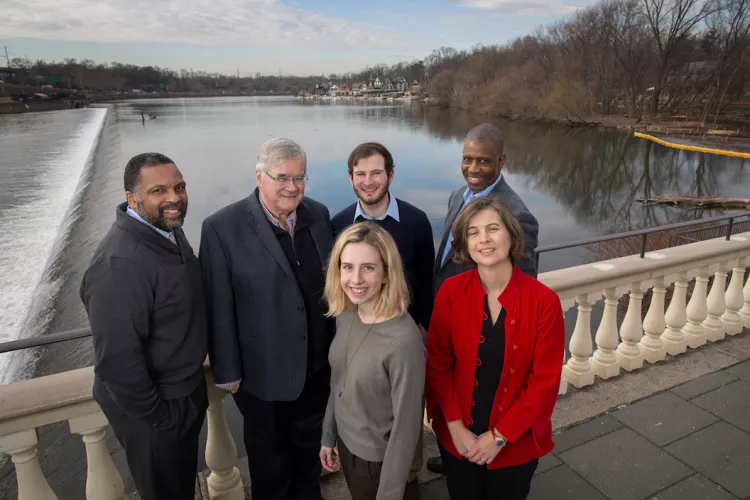
Partnering on the five-year, $1 million stormwater management project (clockwise from left): community partner Jerome Shabazz, executive director of the Overbrook Environmental Education Center; Professor of Engineering Art McGarity, the project's principal investigator; Jonathan Cohen ’17, graduate student researcher at the UC Davis Center for Watershed Sciences; Arto Woodley, Lang Center Scholar-in-Residence, 2015-2017; Tina Rosan, assistant professor of geography and urban studies at Temple University and co-principal investigator; and data operations associate Alexandra Philyaw ’17.
Look no further than Professor of Engineering Art McGarity’s five-year stormwater management project, which discovered that green infrastructure can mitigate cities’ runoff woes, for the interdisciplinary spirit of Swarthmore and potential dynamism of the new Maxine Frank Singer '52 Hall.
It’s an engineering story, with students, faculty, and community partners exploring solutions for Philadelphia’s stormwater runoff problem, working off of a $1 million research grant from the Environmental Protection Agency. It’s a biology story, with students seeking to grow edible plants from stormwater collected on campus, which other students used to examine whether bacteria can sense the presence of metals. It’s a psychology story, which can be boiled down to this: Can people ever get past the “yuck” factor of using dirty runoff from the streets to grow crops?
And it’s a developing story. Although the initial project recently concluded, it continues to generate new lines of inquiry and partnerships, on campus and throughout the Delaware Valley.
“In many ways, I’m sorry to see this project end,” says McGarity, who served as its principal investigator. “But in others, it feels like it’s just getting started.”
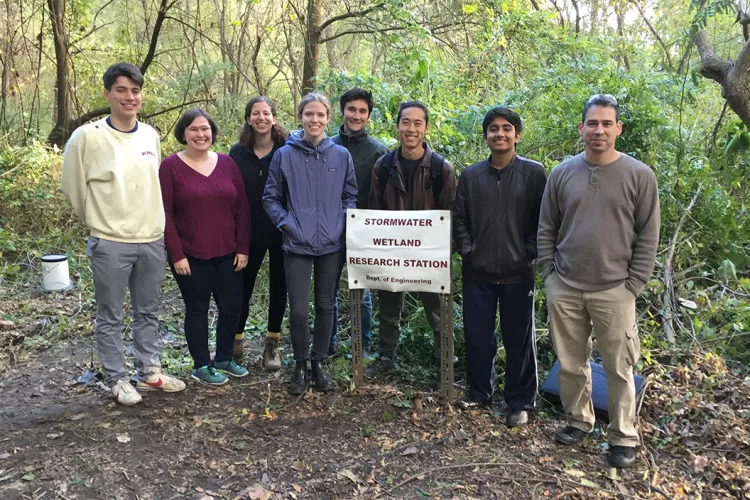
The seven Water Quality and Pollution students and Machine Shop Supervisor J. Johnson (far right) at the Stormwater Wetland Research Station in the Crum Woods.
The efforts of the GreenPhilly Research Group—which also included co-principal investigators Megan Heckert, formerly a visiting professor at the College and now of West Chester University; Benjamin Hobbs of Johns Hopkins University; Christina Rosan of Temple University; and Claire Welty of the University of Maryland, Baltimore County—are summarized on the team’s website and described by McGarity on the Academic Minute podcast.
The big news is that the team’s modeling of a watershed in Philadelphia shows that green stormwater infrastructure—including tree trenches, rain barrels, gardens, and pervious paving—can mitigate the contamination of creeks and rivers caused by spills of sewer water during storms. This pioneering approach has major implications for the more than 100 U.S. cities, including Philadelphia, that are limited to just one pipe for disposal of both urban stormwater runoff and sewer water contaminated by human waste.
Another exciting byproduct of the project is StormWISE, an app the team developed to show dynamically how much financial investment in green water infrastructure is needed to create the desired effect on the community—the type of modeling and clearly communicated data sought for decades.
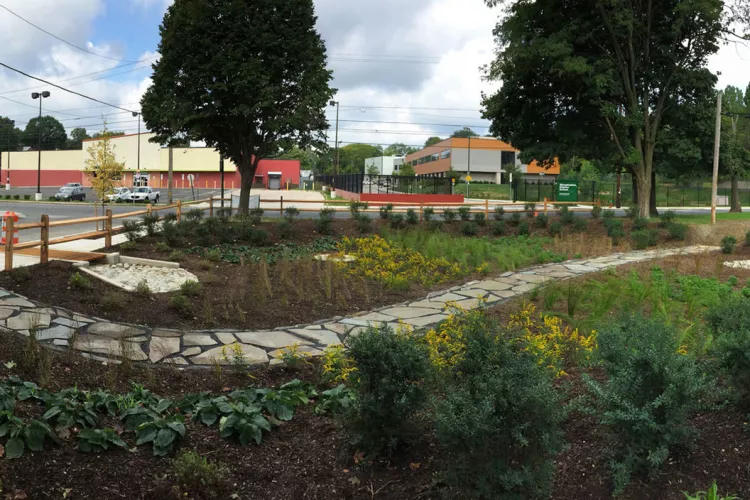
McGarity's team showed that green stormwater infrastructure — including rain gardens like this one in Philadelphia — can mitigate the contamination of creeks and rivers caused by spills of sewer water during storms.
But perhaps even more exciting are the ongoing impacts of the people who collaborated on the project. McGarity involved many Swarthmore students over the years—some of whom are continuing these and related efforts in graduate school—and placed others in related internships in West Philadelphia through the Lang Center for Civic and Social Responsibility.
Those branches continued to grow during McGarity’s sabbatical last year, when he obtained College funding to integrate ideas from the GreenPhilly project into the curriculum. Specifically, he wanted to see whether runoff collected in the Crum Woods could be used to grow something edible.
That ignited an exercise in his Water Quality and Pollution class, for which seven students and Machine Shop Supervisor J. Johnson brought stormwater to the Biology Department’s greenhouse. Aided by Greenhouse Manager Rhonda Hilt, who coordinated access to the facility and advised the team on plant species, they successfully grew amaranth, a leafy salad vegetable that can also be used as a grain.
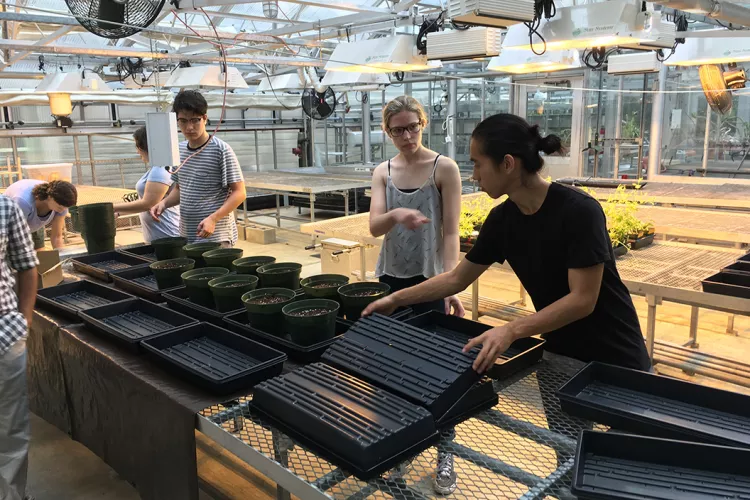
The team used the Biology Department greenhouse to plant seeds for its experiment.
“The biggest takeaway for me was the valuable experience with project management and lab work from the hands-on approach this project took,” says Terrence Xiao ’20, an engineering and environmental studies major and President’s Sustainability Research Fellow (PSRF) from China. “It required integration of theories we learned in class, their applications in the real world, along with all of the logistical minutiae and on-the-fly problem-solving that comes with it.”
“It allowed me to transition to the rigors and requirements of performing STEM research at the college level,” says Muhammad Ghazi Randhawa ’22, of Pakistan, who persuaded McGarity to let him take an advanced engineering course as a first-year student and went on to become his research assistant. “Participating actively in my interest of sustainable urban development was a really productive and mind-opening experience.”
To grow the plants, the engineering students needed the lighting system and deionized, pure water in the greenhouse. They brought the plants back to the engineering labs to measure their metal content, which yielded helpful data, says McGarity.
They also reciprocated, sharing the collected stormwater with students of Amy Cheng Vollmer, the Isaac H. Clothier Jr. Professor of Biology, who needed samples for a study on the potential for bacteria to sense or even measure the presence of metals or elevated metals.
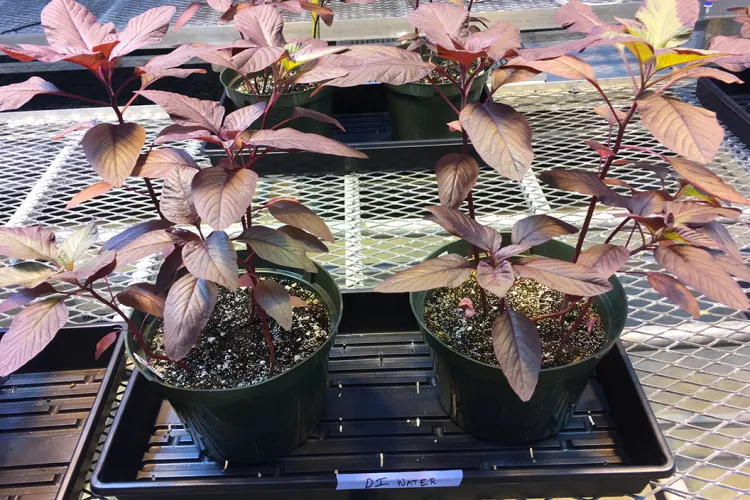
They successfully grew a leafy salad vegetable, amaranth, from stormwater.
“We’ve had that type of collaboration between engineering and biology for years, often related to the environment,” says McGarity. “But this actual sharing of facilities [with engineering, biology, and psychology under one roof in Singer Hall] will make that so much easier. That’s a huge step in the right direction for the College.”
Also folded into the project were 30 students from a core engineering course taught by McGarity who needed lab experience with collecting and analyzing data. The list of participants figures to keep growing—at least until the research team figures out how to get people beyond that ickiness factor and willing to consume crops grown with polluted water.
“Even if we can guarantee with measurement that it’s clean enough and safe to eat, there is still going to be that psychological factor, and it’s a big one,” McGarity says.
“But if there were a psychologist interested in studying that,” he adds, pausing and smiling for a moment, “that could be really good.”
Swarthmore is investing in its vibrant intellectual culture. Learn how at lifechanging.swarthmore.edu.



